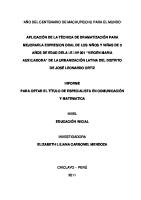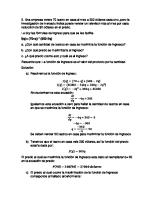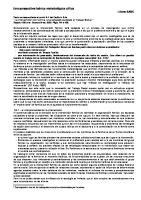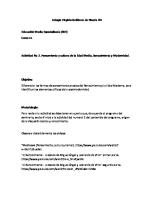Blanca Liliana Moreno.practice Activities
Practice Activities – M&R SUBJECT PRACTICE ACTIVITIES ENGLISH IN THE COMMUNITY Blanca Liliana Moreno Yonda GROUP COFP
Views 581 Downloads 24 File size 126KB
Recommend stories
- Author / Uploaded
- blanca liliana moreno yonda
Citation preview
Practice Activities – M&R
SUBJECT PRACTICE ACTIVITIES ENGLISH IN THE COMMUNITY
Blanca Liliana Moreno Yonda
GROUP COFPMTFL1163352
Date: February 3rd,2019
1
Practice Activities – M&R
Practice Activities Graddol (2006, p.14) states as a key trend to be expected “the rise and fall of learners”. That is, claims that “a massive increase in the number of people learning English has already begun, and is likely to reach a peak around 2 billion in the next 10-15 years. Numbers of learners will then decline.” (ibid, p.14) Bearing in mind this statement, complete the following tasks. Task 1 - (1 page)
More than 10 years have gone by since the original statement. Find updated figures supporting or refuting the hypothesis. If possible, find sources for the last five years. English has been and still is the dominant global language in present world. Today, English as other languages in the past has gained the label of being the Lingua Franca which is broadly used as a means of communication by several speakers of other languages around the world. 50 years ago, Mandarin and English were the first and second most spoken language but this rank has changed and current figures given by The Etnologue Language of The World states that Chinese is spoken in 38 countries with 1.299 million then Spanish spoken in 31 countries with 442 million. These figures display how English has been displaced to a third position with 378 million of speakers in 118 countries. Based on these figures and In David Graddol´s future forecast, it is clear that English is and will continue keeping its position as a Global Language that has been rapidly spreading around the world but also transforming it. Regarding this Graddol (2006) asserts that “the spread of English is helping to transform the world and in which English, in turn, is transformed by the world.” Since this view globalization and English are mutually aligned to coexist together. On the other hand, as English is the predominant medium of communication for many international and local issues its role is addresses to facilitates the interaction among speakers whose first language is not English. Crystal (cited by Seidlhofer 2005) stands that only one out of every four users of English in the world is native and that many of the interactions occurs among nonnative speakers of the language. This kind of international contact has led the English to adopt the name of Lingua Franca. According to a British Council's report "The English Effect." (2013) The number of English learners around the world is only expected to grow. By 2018 the number of 2
Practice Activities – M&R
English learners worldwide reached 1,5 billion, figures given by Knagg (cited by Bentley). By 2020 it is expected that 2 billion of people will be learning English.
Task 2 - (1 page) Present the updated figures in table form comparing them to Graddol’s statements and own figures. Analyze the evolution and state whether Graddol’s hypothesis has been sustained or refuted. Bear in mind: -
How do you define English learners. How do your figures count English learners. Where do your sources come from (remember Task 1). Whether the trend has stop growing or not yet.
The graph compares relevant data about the number of people learning English in million and billion in different periods. While the first three bars show an estimate of English learners given by David Graddol in three different years 2005, 2010 and 2050, the second group of bars show data given by the British Council in the periods of 2018 and 2020. Overall, the first bar chart shows that by 2005 there were approximately 1.100 million of English learners, then these figures went up in 2010 reaching a peak of 2 billion indicating a dramatic increase of 900 million. For the next 30 years the figures will tend to decrease to around 500-600 million by 2050. Indicating a fall of 1.500 million of people learning English. 3
Practice Activities – M&R
The British Council, also offers some figures starting in the year 2018 in which there were 1,5 billion of English learners worldwide. Thereafter, and by 2020 it es expected that the number of English learner will increase in 5 million reaching 2 billion for this period. The results show that Graddol´s hypothesis is true to some extend given that evidently the number of English learners will have increased up to 2 billion but differ in the years of 2010 (Graddol) and 2020 (British Council). Being this the only fact these authors have in common.
Task 3 - (1 page) Based on the figures you had, propose your own claim to the future development of English as a Foreign Language. Take into account the figures you found, the materials of the class, the readings available in the campus and other external sources that you might deem relevant. After years of great impact over society English is still consider a “global authority” that has its roots strongly tied to its past. Either British or American, nations and citizens tend to learn this language for diverse reasons but with one aim in common: communication. From this perspective, and despite the fact that some studies point out that English will decline in a short or long future and from the figures given by researchers regarding other languages replacing it I would dare to say that this language will continue been adopting and teaching learning for several globally. English will preserve its language power and position among the three most spoken (Chinese and Spanish). As the future is unknown and figures could change at any time English could be placed once more in its initial first position or in contrast moved to a fourth position being displaced by the Arabic, language which is expanding rapidly and spoken by 58 countries. (Graddol. 2006. p, 60) What is certain is that due to China´s industry, business and different trades with other nations it will continue growing in importance but with difficulty will overtake English. On the other hand, to avoid decreasing in number of English speakers, the united states which is the major supplier will subside third world countries building specialized programs in order to make its language prevail over other languages specially Chinese 4
Practice Activities – M&R
and Spanish, what is more, this country will continue building programs for English teachers worldwide aimed to maintain, conserve and expand the language to all parts of the world very much in spite of the different variations or Englishes which affects the richness and authenticity of the language. That is to say that offering and training teachers under these programs they will become into multipliers of English avoiding its reduction or extinction. To conclude this prediction, I quote Joseph Osoba (cited by Mustafizur. nd) with and interesting view regarding the permanence of English. “In Nigeria or elsewhere, I think, as far as America remains the world’s number one superpower, the English language will attain the status of a true and sole international or global language. It will still be the language of science and technology, international educational research, including space research, and international diplomacy. It will still remain the most dominant and enduring international language, though with more local varieties.”
References.
5
Practice Activities – M&R
Beare, Kenneth. "How Many People Learn English?" ThoughtCo, Oct. 8, 2018, retrieved from: thoughtco.com/how-many-people-learn-english-globally-1210367 Etnologue Language of the World. (2018). Summary by language size. Table 3. Languages with at least 50 million first-language speakers. Retrieved from: https://www.ethnologue.com/statistics/size Mustafizur, R. The future of English language: Will English retain its current global position in the next 50 years? Seidlhofer, B. (2005) English as a Lingua Franca. ELT Journal Volume 59/4 October 2005; doi:10.1093/elt/cci064 The British Council. (2013). The English Effect. Retrieved from: https://www.britishcouncil.org/sites/default/files/english-effect-report-v2.pdf
6









